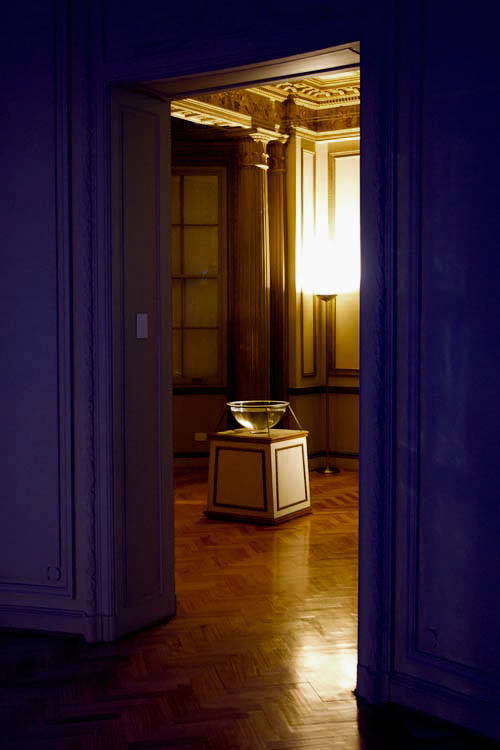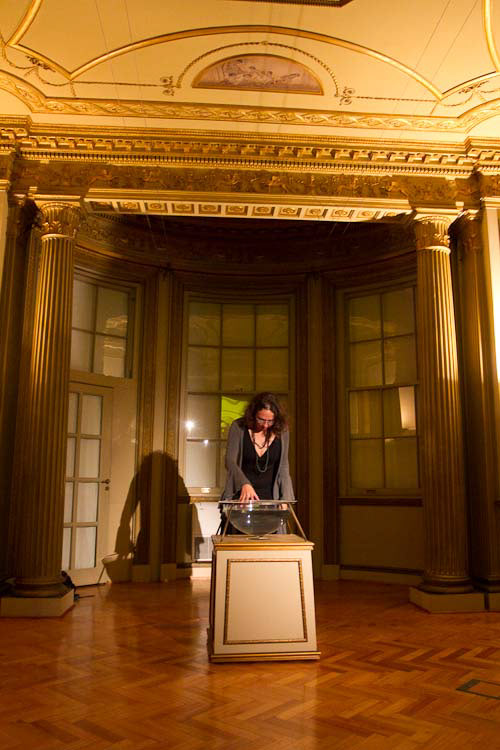Interactive Mixed Media installation. Variable sizes.
[VIDEO: Record of installation]
[VIDEO: Record of installation]
Exhibition / Exhibición
Espacio de Arte Fundación OSDE. Buenos Aires, Argentina. June 2013.
In collaboration with IQLAB (Gerardo Della Vecchia, Bernardo Piñero y Natalia Pajariño).
Commission by curator María Teresa Constantín for the salitas space at OSDE Foundation Art Space.
In collaboration with IQLAB (Gerardo Della Vecchia, Bernardo Piñero y Natalia Pajariño).
Commission by curator María Teresa Constantín for the salitas space at OSDE Foundation Art Space.
Conceptual memory
Doña Cecilia, a neighbor of a remote town in Spain, acted with the best of intentions. Sustained by her unwavering faith, she transformed the Son of God into an Ecce Monkey. And she didn't think of Bacon. She had no idea who he was. Thus that archetypal face that contains all the mercy of our Creator for his sinful creatures, that gaze to heaven, that suffering that encompasses us all, was replaced by the sympathetic roundness of an ape.
The face is a map of our identity. That unique combination of skin, bones, muscles and holes that seeks to impose its particularity on hundreds and thousands of other faces, all the other things in the world. If the body is the temple, the face is the altar.
“When you see yourself in the reflection, shape and reflection look at each other. You are not the reflection, but certainly the reflection is you, ”says Tozan Ryokai in the Samadhi of the precious mirror. One is because his image exists. It gives us back that singularity of traits that build the self. But if that image disintegrates, do we disintegrate?
The device presented as a site-specific and interactive work proposes to the visitor a questioning of his face as a hallmark of identity. As in a sanctuary (accentuated by the use of the architectural style of the rooms), the work evokes a space contained in darkness and silence, a place for an introspective journey. The visitor, inadvertently, acts as Doña Cecilia's hand, and will surely react as Dorian Gray, or as Dr. Jeckyll, or more simply and tragically, as Narcissus.
You are all warned.
///ESP///
Instalación interactiva. Medidas variables.
[VIDEO: Registro de instalación]
Instalación interactiva. Medidas variables.
[VIDEO: Registro de instalación]
Memoria conceptual
Doña Cecilia, vecina de un recóndito pueblo de España, actuó con las mejores intenciones. Sostenida por su fe inquebrantable, transformó al Hijo de Dios en un Ecce Mono. Y no pensó en Bacon. No tiene la menor idea de quién fue. Así aquel rostro arquetípico que encierra toda la piedad de nuestro Creador por sus criaturas pecadoras, esa mirada al cielo, ese sufrimiento que nos abarca a todos, fue reemplazado por la redondez simpática de un simio.
El rostro es un mapa de nuestra identidad. Esa combinación única de piel, huesos, músculos y agujeros que busca imponer su particularidad ante cientos y miles de otras caras, todas las otredades del mundo. Si el cuerpo es el templo, el rostro es el altar.
“Al verte en el reflejo, forma y reflejo se miran. Tú no eres el reflejo, pero ciertamente el reflejo eres tú”, dice Tozan Ryokai en el Samadhi del precioso espejo. Uno es porque existe su imagen. Ella nos devuelve esa singularidad de rasgos que construyen el yo. Pero si esa imagen se deshace, ¿nos deshacemos?
El dispositivo presentado como obra in situe interactiva propone al visitante un cuestionamiento de su rostro como sello de identidad. A manera de santuario (acentuado por el uso del estilo arquitectónico de las salas), la obra propone un espacio contenido en la oscuridad y el silencio, un lugar para el viaje introspectivo. El visitante, sin quererlo, actúa como la mano de Doña Cecilia, y seguramente reaccione como Dorian Grey, o como el Dr. Jeckyll, o más simple y trágicamente, como Narciso.
Quedan advertidos.









